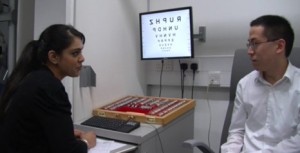This is a summary of the work I presented at the Health Has Got Talent event 2015.
As an optometry student, some of the most important parts of the degree is to perfect your ability to perform an eye test, diagnose eye diseases, and manage patients. All optometry students will have to abide by the Code of Conduct (Standards of Practice from April 2016) set out by the General Optical Council. Listening to patients and ensure that they are at the heart of the decisions made about their care is part of these standards. Another is to communicate effectively, and show care and compassion for your patients.
The reason for this service user project was the lack of empathy often observed during supervision in our eye clinic. It is known that final year students mainly focus on completing an eye test on time, but often do not understand the implications of what is being said from the patient’s perspective. Maybe not surprising, communication and empathy are often forgotten when students are being assessed; they focus on obtaining their core competencies and compassion towards the patient possibly comes second to that. Additionally, from my PG teaching experience I realised that there is a lack of understanding what the effect of certain eye diseases have on the daily life of our patients.
I designed a new series of tutorials for UG and PG Optometry Programmes, whereby service users with common eye diseases discuss their everyday experience of the disease, their experiences of the national screening services, and any treatment received by eye care professionals. Together with City Sight clinic lead Mark Mayhew, we created online tutorials included interviews with the service users at different stages of the eye examination, including tips on (new) clinical skills techniques. On separate occasions these service users supported dialogues with small groups of students regarding their everyday experiences coping with the disease. By introducing the service user perspective to undergraduate optometry students, I envisaged that the improved understanding of the patient perspective would translate into enhanced communication skills and optometric management when students’ progress to the professional eye clinics in their final year of study.

The online videos and tutorials were incredibly well received by all students. Feedback included comments like
• You don’t really comprehend the magnitude of the illness and impact on patient until you talked to someone who has got the disease;
• It is a great opportunity to hear what the patients have to say about past experiences as well as how they would like to be tested and aided;
• Really helpful, please continue doing them; and
• Best of all, it has made me a better optometrist!
The project provided a great opportunity to link all modules together in year 3 of the Programme. The tutorials are not linked to a specific module, but create a bridge between several modules such as Communication, Clinical Skills, Professional Skills, and Eye Disease. And this educational project can easily be built on by introducing other eye diseases and conditions.
Top tip for those inspired by introducing service users to their teaching sessions: find a quiet place for filming and/or tutorials 🙂



Leave a Reply